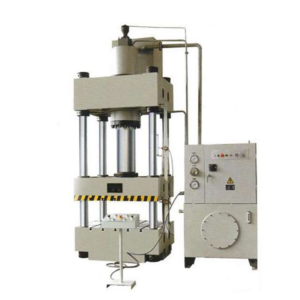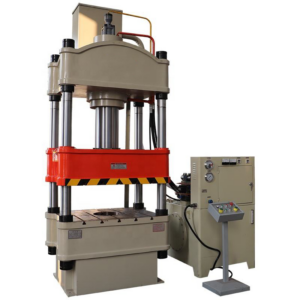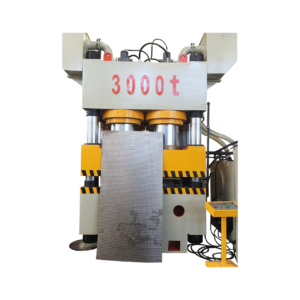In industrial manufacturing, four-column hydraulic presses perform a variety of tasks and are widely used across many processing techniques. Despite their versatility, these presses often experience similar faults during operation. Therefore, it is essential to understand the causes of these faults and know how to fix them in order to improve production efficiency, extend the equipment’s lifespan, and minimize downtime.
Types and Characteristics of Hydraulic Presses
Four-column hydraulic presses come in various types, each designed for specific functions. The most common type is the general-purpose four-column hydraulic press, such as the YG32 series. This model uses a computer-optimized design and an integrated cartridge valve system for hydraulic control. As a result, it provides reliable operation, a long service life, and minimal leakage points, making it ideal for a broad range of applications.
Specialized four-column hydraulic presses, such as the Y32-1200B and Y32-1800B models, are designed for specific tasks. These presses handle cold and hot forming of pressure vessel heads, as well as pressing and folding thick and thin steel plates. These machines usually have nominal forces ranging from 3500KN to 4500KN, and they can operate under a maximum working liquid pressure of 25MPa, making them suitable for heavy-duty applications.
Two-beam four-column hydraulic presses, such as the YW31-100T, feature dual control of constant pressure and constant stroke. Their three-stage speed design of the slide block balances accuracy with cycle time. This flexibility allows the machine to handle multiple processes, such as pressing, straightening, stretching, and stamping. Despite their varied applications, all of these presses work on the same basic principle: they use hydraulic pressure to perform mechanical tasks.

Common Faults and Causes
Abnormal pressure remains one of the most common problems with four-column hydraulic presses. For example, the YC32-315 hydraulic press might show a system pressure gauge reading of only 5 MPa instead of the expected 32 MPa, causing the main cylinder to fail to maintain the required pressure during its downward motion. Similarly, when the main cylinder moves down, the ejector cylinder piston rod might move upwards, exhibiting 4 MPa of pressure, directly causing malfunction.
Action failure is another frequent issue. This problem often arises due to loose or incorrect electrical wiring, insufficient oil in the tank, or air accumulating in the hydraulic system. Slider creep can occur when air is trapped in the system, or when precision adjustments are improper. Insufficient oil in the column can also contribute to this problem.
Downward pressure problems typically arise when the support pressure is too high. Operators can address this by adjusting the pilot valve. Similarly, severe slider slippage after stopping is often caused by oil leakage from cylinder seals, insufficient pilot valve pre-adjustment pressure, or poor sealing of the cartridge valve port. These issues generally result from three primary factors: contamination, overheating, and air ingress. Research shows that these three factors account for roughly 75% of hydraulic system failures.
Troubleshooting Methods
To fix malfunctions quickly, operators must follow effective troubleshooting methods. For pressure failures, operators should conduct thorough analysis and tests. In the case of the YC32-315 hydraulic press, repeated adjustments may be required to resolve the issue.
When facing action failures, operators should check the electrical wiring against the diagram to ensure secure connections. It is also critical to verify the oil level in the tank and add oil as needed.
For slider creep, operators must inspect the suction pipe and run the system up and down while pressurizing to remove trapped air. If precision is the issue, recalibrate the press. Applying oil to the column surface can also solve lubrication-related issues.
Downward pressurization problems are often resolved by adjusting the pilot valve to ensure the operating pressure doesn’t exceed 1 MPa. To fix slider slippage after stopping, operators should inspect and replace damaged seals. Additionally, adjusting the pilot valve pressure and refitting the cartridge valve orifice should help.
For erratic pressure gauge pointer movements, operators need to release trapped air by loosening the connectors during pressurization. They should also inspect pipes for looseness and tighten them if necessary. If the pressure gauge is damaged, replacing it will fix the problem.
Safety Operating Procedures
Proper operating methods are crucial for preventing malfunctions and ensuring the safe operation of four-column hydraulic presses. Operators must undergo training to understand the equipment’s performance, operating techniques, and safety protocols.
Before starting the machine, operators should clean all debris from the mold and wipe dirt off the hydraulic press rods. Mold installation should always take place with the power off, and operators should avoid pressing the start button or foot switch until all preparations are complete. Once the equipment powers on, operators should let it run idle for 5 minutes. During this time, they should check the oil level, listen for unusual pump sounds, and inspect for leaks in the hydraulic unit, pipes, joints, or pistons.
After these checks, operators should perform a pressure test to verify the equipment reaches the required working pressure. They must then test one workpiece to ensure everything works correctly before beginning production. While adjusting the working pressure, operators should never exceed 90% of the equipment’s rated pressure. Once the test press passes inspection, production can begin.
Safety precautions are essential during operation. Operators must never place their hands or heads into the working area while the press plate is in motion. It is strictly prohibited to strike, stretch, weld, cut, bend, or twist the workpiece while under pressure. Additionally, smoking, welding, or using open flames near the hydraulic press should be avoided. Operators should also ensure that no flammable materials are stored near the equipment.
In conclusion, to achieve maximum efficiency and extend the lifespan of four-column hydraulic presses, operators must fully understand the equipment’s operating principles and adhere strictly to safety procedures. With proper training, regular maintenance, and attention to detail in both operation and troubleshooting, operators can minimize downtime and optimize machine performance.



